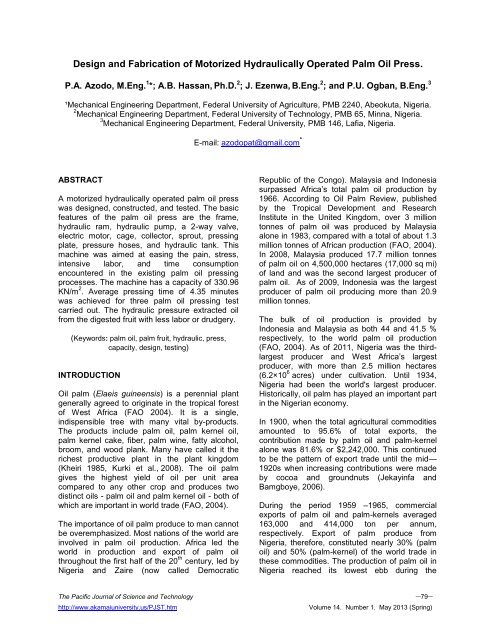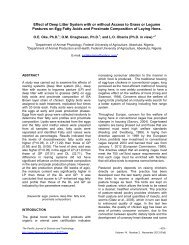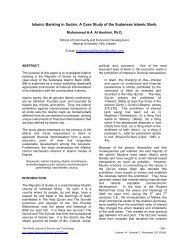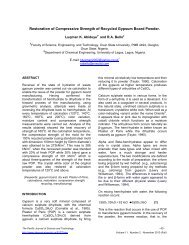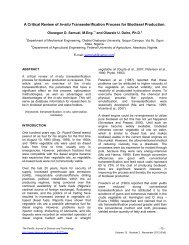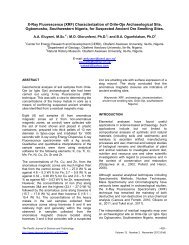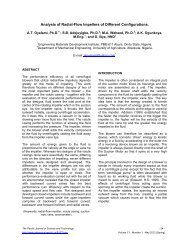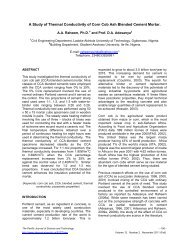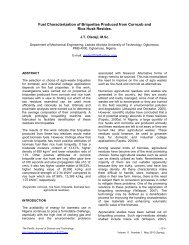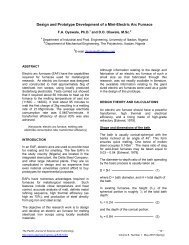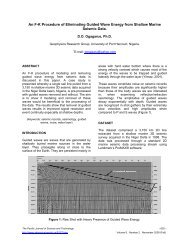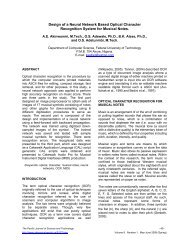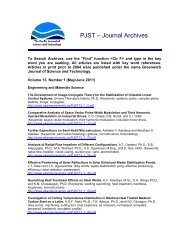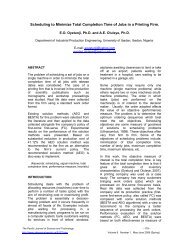Design and Fabrication of Motorized Hydraulically Operated Palm ...
Design and Fabrication of Motorized Hydraulically Operated Palm ...
Design and Fabrication of Motorized Hydraulically Operated Palm ...
You also want an ePaper? Increase the reach of your titles
YUMPU automatically turns print PDFs into web optimized ePapers that Google loves.
<strong>Design</strong> <strong>and</strong> <strong>Fabrication</strong> <strong>of</strong> <strong>Motorized</strong> <strong>Hydraulically</strong> <strong>Operated</strong> <strong>Palm</strong> Oil Press.<br />
P.A. Azodo, M.Eng. 1 *; A.B. Hassan, Ph.D. 2 ; J. Ezenwa, B.Eng. 2 ; <strong>and</strong> P.U. Ogban, B.Eng. 3<br />
¹Mechanical Engineering Department, Federal University <strong>of</strong> Agriculture, PMB 2240, Abeokuta, Nigeria.<br />
2 Mechanical Engineering Department, Federal University <strong>of</strong> Technology, PMB 65, Minna, Nigeria.<br />
3 Mechanical Engineering Department, Federal University, PMB 146, Lafia, Nigeria.<br />
E-mail: azodopat@gmail.com *<br />
ABSTRACT<br />
A motorized hydraulically operated palm oil press<br />
was designed, constructed, <strong>and</strong> tested. The basic<br />
features <strong>of</strong> the palm oil press are the frame,<br />
hydraulic ram, hydraulic pump, a 2-way valve,<br />
electric motor, cage, collector, sprout, pressing<br />
plate, pressure hoses, <strong>and</strong> hydraulic tank. This<br />
machine was aimed at easing the pain, stress,<br />
intensive labor, <strong>and</strong> time consumption<br />
encountered in the existing palm oil pressing<br />
processes. The machine has a capacity <strong>of</strong> 330.96<br />
KN/m 2 . Average pressing time <strong>of</strong> 4.35 minutes<br />
was achieved for three palm oil pressing test<br />
carried out. The hydraulic pressure extracted oil<br />
from the digested fruit with less labor or drudgery.<br />
(Keywords: palm oil, palm fruit, hydraulic, press,<br />
capacity, design, testing)<br />
INTRODUCTION<br />
Oil palm (Elaeis guineensis) is a perennial plant<br />
generally agreed to originate in the tropical forest<br />
<strong>of</strong> West Africa (FAO 2004). It is a single,<br />
indispensible tree with many vital by-products.<br />
The products include palm oil, palm kernel oil,<br />
palm kernel cake, fiber, palm wine, fatty alcohol,<br />
broom, <strong>and</strong> wood plank. Many have called it the<br />
richest productive plant in the plant kingdom<br />
(Kheiri 1985, Kurki et al., 2008). The oil palm<br />
gives the highest yield <strong>of</strong> oil per unit area<br />
compared to any other crop <strong>and</strong> produces two<br />
distinct oils - palm oil <strong>and</strong> palm kernel oil - both <strong>of</strong><br />
which are important in world trade (FAO, 2004).<br />
The importance <strong>of</strong> oil palm produce to man cannot<br />
be overemphasized. Most nations <strong>of</strong> the world are<br />
involved in palm oil production. Africa led the<br />
world in production <strong>and</strong> export <strong>of</strong> palm oil<br />
throughout the first half <strong>of</strong> the 20 th century, led by<br />
Nigeria <strong>and</strong> Zaire (now called Democratic<br />
Republic <strong>of</strong> the Congo). Malaysia <strong>and</strong> Indonesia<br />
surpassed Africa’s total palm oil production by<br />
1966. According to Oil <strong>Palm</strong> Review, published<br />
by the Tropical Development <strong>and</strong> Research<br />
Institute in the United Kingdom, over 3 million<br />
tonnes <strong>of</strong> palm oil was produced by Malaysia<br />
alone in 1983, compared with a total <strong>of</strong> about 1.3<br />
million tonnes <strong>of</strong> African production (FAO, 2004).<br />
In 2008, Malaysia produced 17.7 million tonnes<br />
<strong>of</strong> palm oil on 4,500,000 hectares (17,000 sq mi)<br />
<strong>of</strong> l<strong>and</strong> <strong>and</strong> was the second largest producer <strong>of</strong><br />
palm oil. As <strong>of</strong> 2009, Indonesia was the largest<br />
producer <strong>of</strong> palm oil producing more than 20.9<br />
million tonnes.<br />
The bulk <strong>of</strong> oil production is provided by<br />
Indonesia <strong>and</strong> Malaysia as both 44 <strong>and</strong> 41.5 %<br />
respectively, to the world palm oil production<br />
(FAO, 2004). As <strong>of</strong> 2011, Nigeria was the thirdlargest<br />
producer <strong>and</strong> West Africa’s largest<br />
producer, with more than 2.5 million hectares<br />
(6.2×10 6 acres) under cultivation. Until 1934,<br />
Nigeria had been the world's largest producer.<br />
Historically, oil palm has played an important part<br />
in the Nigerian economy.<br />
In 1900, when the total agricultural commodities<br />
amounted to 95.6% <strong>of</strong> total exports, the<br />
contribution made by palm oil <strong>and</strong> palm-kernel<br />
alone was 81.6% or $2,242,000. This continued<br />
to be the pattern <strong>of</strong> export trade until the mid—<br />
1920s when increasing contributions were made<br />
by cocoa <strong>and</strong> groundnuts (Jekayinfa <strong>and</strong><br />
Bamgboye, 2006).<br />
During the period 1959 –1965, commercial<br />
exports <strong>of</strong> palm oil <strong>and</strong> palm-kernels averaged<br />
163,000 <strong>and</strong> 414,000 ton per annum,<br />
respectively. Export <strong>of</strong> palm produce from<br />
Nigeria, therefore, constituted nearly 30% (palm<br />
oil) <strong>and</strong> 50% (palm-kernel) <strong>of</strong> the world trade in<br />
these commodities. The production <strong>of</strong> palm oil in<br />
Nigeria reached its lowest ebb during the<br />
The Pacific Journal <strong>of</strong> Science <strong>and</strong> Technology –79–<br />
http://www.akamaiuniversity.us/PJST.htm<br />
Volume 14. Number 1. May 2013 (Spring)
Nigerian civil war (1966–1970). It was estimated<br />
in 1978 that Nigeria became a net importer <strong>of</strong><br />
palm oil with 3000 tons worth $16 million<br />
(Jekayinfa <strong>and</strong> Bamgboye, 2006). Though, latter<br />
in 1987, her exports increased to about 6.5 million<br />
tones, which earned her the third largest exporter<br />
<strong>of</strong> oil that year (Omuta <strong>and</strong> Onorkahrage, 1997).<br />
This was possible because the Federal<br />
Government <strong>of</strong> Nigeria introduced the Structural<br />
Adjustment Programme (SAP) which led to the<br />
prohibition <strong>of</strong> importation <strong>of</strong> some essential<br />
products (including soap, cooking oil <strong>and</strong><br />
body/hair cream) as policy measures to revive the<br />
economy, minimize the dependence on<br />
importation <strong>and</strong> to build a non-oil export based<br />
economy (Aina, 2002).<br />
These policy measures rekindled an interest in<br />
agriculture on the part <strong>of</strong> many Nigerians <strong>and</strong><br />
Nigerian organizations. The government through<br />
different agencies likes Agricultural Development<br />
Projects (ADPs), Directorate <strong>of</strong> Foods, Road <strong>and</strong><br />
Rural Infrastructure (DFFRI) <strong>and</strong> Federal Institute<br />
<strong>of</strong> Industrial Research Oshodi (FIIRO) made<br />
efforts to increase local production <strong>of</strong> these<br />
essential commodities through incentives given to<br />
farmers <strong>and</strong> organizations (Aina, 2002; Jekayinfa,<br />
2004; Olajide & Oyelade, 2002). To effectively<br />
revitalize Nigeria palm oil processing sector, there<br />
is need to improve the design <strong>of</strong> the palm oil<br />
machine, the palm oil extractor, for productivity,<br />
efficiency, ergonomics <strong>and</strong> safety <strong>of</strong> h<strong>and</strong>ling the<br />
machine. Through this cost effectiveness,<br />
conducive <strong>and</strong> environmentally friendly operating<br />
conditions will be achieved.<br />
PALM OIL EXTRACTION METHODS<br />
Various techniques may be used to process palm<br />
oil fruits for edible oil. The extraction <strong>of</strong> palm oil is<br />
done using either the traditional methods or<br />
through the use <strong>of</strong> machines which can either be<br />
manually or mechanically operated.<br />
THE TRADITIONAL METHOD OF OIL<br />
EXTRACTION<br />
The traditional method <strong>of</strong> palm oil extraction<br />
started before the advent <strong>of</strong> machinery. This is a<br />
crude means that gives a product poor quality.<br />
The traditional method <strong>of</strong> oil extraction consists <strong>of</strong><br />
steeping the pounded fruit mash in hot or cold<br />
water; removing fiber <strong>and</strong> nuts in small baskets<br />
<strong>and</strong> h<strong>and</strong> squeezing; filtering out residual fiber<br />
from the oil/water emulsion in perforated metal<br />
col<strong>and</strong>ers or baskets; boiling <strong>and</strong> skimming palm<br />
oil from the oil/water mixture; drying the<br />
recovered oil. St<strong>and</strong>ing by the open fire during<br />
this operating period is not only a health hazard<br />
but is inefficient, as a lot <strong>of</strong> oil is left trapped in<br />
the mixture as an emulsion. In the traditional<br />
method, two major types <strong>of</strong> oil are produced: S<strong>of</strong>t<br />
oil <strong>and</strong> the hard oil (Asiedu, 1989).<br />
MECHANICAL METHODS OF EXTRACTION<br />
OF PALM OIL<br />
Within increasing dem<strong>and</strong> for palm oil from the<br />
west coast <strong>of</strong> Africa; it was clear even by the turn<br />
<strong>of</strong> the century that tradition methods <strong>of</strong> extraction<br />
could not satisfy either dem<strong>and</strong> or quality<br />
requirements <strong>and</strong> that they gave a very meager<br />
return to the producer. Consideration was<br />
therefore given to providing oil extraction<br />
methods, which could be easily adopted by the<br />
small or large producer (Asiedu, 1989).<br />
MATERIALS AND METHODS<br />
Parts <strong>of</strong> the <strong>Palm</strong> Oil Press<br />
The palm oil press is made up <strong>of</strong> the following<br />
units: the frame, hydraulic ram, hydraulic pump, a<br />
2-way valve, electric motor, cage, collector,<br />
sprout, pressing plate, <strong>and</strong> hydraulic tank (Figure<br />
1).<br />
<strong>Design</strong> <strong>and</strong> Construction<br />
The constructional detail <strong>of</strong> each <strong>of</strong> the separate<br />
components that make up the press is discussed<br />
below;<br />
Frame: Weight <strong>of</strong> the electric motor, the valve,<br />
the hydraulic pump, the hydraulic ram <strong>and</strong> its<br />
supports, hydraulic tank were considered in<br />
designing the frame. U-channel mild steel was<br />
used for the frame for strength <strong>and</strong> rigidity due to<br />
load <strong>of</strong> component parts <strong>and</strong> pressing pressure.<br />
The frame is <strong>of</strong> triangular shape. Sub-supports<br />
like that for electric motor, ram <strong>and</strong> hydraulic tank<br />
were welded to the main frame to provide support<br />
for the various components. 1.5 inch angle bar <strong>of</strong><br />
thickness 3 mm used to fabricate rectangular<br />
seats for the electric motor <strong>and</strong> the hydraulic<br />
tank. Two cylindrical pipes <strong>of</strong> 460mm length, 60<br />
mm diameter <strong>and</strong> 4mm thickness were used to<br />
support the ram.<br />
The Pacific Journal <strong>of</strong> Science <strong>and</strong> Technology –80–<br />
http://www.akamaiuniversity.us/PJST.htm<br />
Volume 14. Number 1. May 2013 (Spring)
Figure 1: Diagram <strong>of</strong> the <strong>Motorized</strong> <strong>Hydraulically</strong><br />
<strong>Operated</strong> <strong>Palm</strong> Oil Press.<br />
Table 1: Parts <strong>of</strong> <strong>Motorized</strong> <strong>Hydraulically</strong><br />
<strong>Operated</strong> <strong>Palm</strong> Oil Press.<br />
S/N PARTS<br />
1 Hydraulic tank<br />
2 Hydraulic tank support<br />
3 Ram support<br />
4 Pressure hose<br />
5 Angle bar<br />
6 Frame<br />
7 Ram rod (piston)<br />
8 Piston palisade<br />
9 Pressing plate<br />
10 Cage<br />
11 Collector<br />
12 Hydraulic pump<br />
13 Electric motor<br />
14 2-way valve<br />
15 Spout<br />
Collector: The collector is a cylinder <strong>of</strong> diameter<br />
660 mm, height 130 mm <strong>and</strong> thickness 5 mm with<br />
one end closed for collecting the oil from the cage<br />
during pressing.<br />
Figure 2: Orthographic Drawing <strong>of</strong> the <strong>Motorized</strong><br />
<strong>Hydraulically</strong> <strong>Operated</strong> <strong>Palm</strong> Oil Press.<br />
Spout: This was cut from a galvanized pipe <strong>of</strong><br />
diameter <strong>and</strong> thickness 40 <strong>and</strong> 2 mm<br />
respectively. This was connected to the opening<br />
in the collector by welding.<br />
Cage: This was made from sheet metal <strong>of</strong><br />
thickness <strong>of</strong> 5 mm. Thickness <strong>of</strong> 5 mm was used<br />
to withst<strong>and</strong> the internal pressure that is built up<br />
due to the pressing pressure. The extraction cuts<br />
on the cage were perforated round staggered <strong>of</strong><br />
diameter <strong>of</strong> 5 mm throughout the circumference<br />
<strong>of</strong> the cage. It was made <strong>of</strong> two halves, joined<br />
with hinges. It has two h<strong>and</strong>les welded to the side<br />
for lifting the cage after the pressing operation.<br />
The diameter <strong>of</strong> the press cage is 400 mm<br />
Pressing Plates: The pressing plate is a steady<br />
steel disc <strong>of</strong> 8 mm thickness. Cut to circular<br />
shape <strong>of</strong> diameter 380 mm. welded to the center<br />
is a nut for attachment to the ram.<br />
Lock pins: These were made from mild steel rod<br />
<strong>of</strong> diameter 10mm. They were made in form <strong>of</strong> a<br />
“Tee” shape by welding. These are locks for the<br />
cage before loading the digested palm pulp into<br />
cage for pressing.<br />
Hydraulic Tank: 2 mm thick mild steel sheet was<br />
used for the hydraulic tank <strong>of</strong> size 200 x 160 x<br />
300 mm. A neck was welded to the top, through<br />
which the hydraulic fluid can be poured into the<br />
tank. An outlet pipe <strong>of</strong> 20 mm in diameter was<br />
welded to the bottom to serve as inlet to the<br />
The Pacific Journal <strong>of</strong> Science <strong>and</strong> Technology –81–<br />
http://www.akamaiuniversity.us/PJST.htm<br />
Volume 14. Number 1. May 2013 (Spring)
pump. Also a diameter 17 mm bolt <strong>and</strong> nut was<br />
weld to the bottom for draining should the tank<br />
needed to be dismantled.<br />
Connecting Hoses: The connecting hoses are<br />
pressure hoses in order to withst<strong>and</strong> the pump<br />
pressure <strong>and</strong> ram pressure.<br />
2-way Valve: The valve required in order for the<br />
machine to perform effectively is a two way valve.<br />
This is to enable the fluid to move to the upper<br />
<strong>and</strong> lower chamber <strong>of</strong> the ram. The 2-way valve<br />
pumps the hydraulic oil to <strong>and</strong> from the hydraulic<br />
tank. It also controls the flow <strong>of</strong> the fluid pressure.<br />
The valve controls the down movement <strong>of</strong> the ram<br />
during pressing operation <strong>and</strong> up movement after<br />
the pressing operation. It is controlled by the lever<br />
<strong>of</strong> the control valve<br />
= = 330.96 KN/m 2<br />
The Power Drive Mechanism<br />
Proper calculation was done to avoid overload,<br />
<strong>and</strong> motor burn due to wrong estimation about<br />
load. The power transmission <strong>of</strong> the machine is<br />
by pulley <strong>and</strong> belt arrangement as shown in<br />
Figure 1. The speed <strong>of</strong> the pump depends on:<br />
i. The speed <strong>of</strong> the electric motor.<br />
ii. The diameter <strong>of</strong> the pulleys.<br />
Hydraulic Pump: Hydraulic pumps are positive<br />
displacement pumps that pumps fluid to create a<br />
non-pulsating pumping action. Hydraulic pumps<br />
are able to pump at high pressures <strong>and</strong> excel at<br />
pumping high viscosity liquids efficiently. The<br />
pump capacity is 1.8 kW. Pump pulley diameter<br />
is 125 mm. The hydraulic ram is controlled by a<br />
hydraulic pump.<br />
Electric Motor: Electric motor is the one <strong>of</strong><br />
common device for rotating equipment <strong>and</strong> it is<br />
useful for smooth operation <strong>and</strong> makes our<br />
process faster <strong>and</strong> more efficient. 5 Hp motor<br />
capacity <strong>and</strong> Speed <strong>of</strong> 1750 rpm was considered<br />
proper <strong>and</strong> suitable for the load, speed <strong>and</strong> the<br />
whole system. Motor pulley diameter is 70 mm<br />
Hydraulic Ram: A 30psi (206.85KN/m 2 ) capacity<br />
hydraulic ram was used for the palm oil press.<br />
The diameter <strong>of</strong> the ram is 250mm.<br />
Figure 2: Arrangement <strong>of</strong> the pulleys.<br />
(Source: Khurmi <strong>and</strong> Gupta 2006)<br />
The selected motor <strong>of</strong> 5 hp delivers at speed <strong>of</strong><br />
1750 rpm which was connected to the hydraulic<br />
pump pulleys. A diameter <strong>of</strong> the motor shaft<br />
pulley <strong>of</strong> 70mm was selected. The pump<br />
speed , was calculated as follows:<br />
DESIGN CALCULATIONS<br />
Determination <strong>of</strong> Hydraulic Pressure <strong>of</strong> the<br />
<strong>Palm</strong> Oil Press: The diameter <strong>of</strong> the ram is given<br />
as 250 mm. The diameter <strong>of</strong> the press cage is<br />
400 mm; hence in order to produce the required<br />
pressure on the fruit, the hydraulic pressure (P h )<br />
must be:<br />
(Khurmi <strong>and</strong> Gupta, 2006)<br />
(Asiedu, 1989)<br />
The Pacific Journal <strong>of</strong> Science <strong>and</strong> Technology –82–<br />
http://www.akamaiuniversity.us/PJST.htm<br />
Volume 14. Number 1. May 2013 (Spring)
Where:<br />
= 980 rpm<br />
= speed <strong>of</strong> electric motor<br />
= speed <strong>of</strong> the pump<br />
= diameter <strong>of</strong> motor pulley<br />
= diameter <strong>of</strong> pump<br />
Where:<br />
= length <strong>of</strong> belt<br />
= diameter <strong>of</strong> motor pulley (smaller pulley)<br />
= diameter <strong>of</strong> pump pulley (larger pulley)<br />
x = distance between the centres <strong>of</strong> two pulleys<br />
Belt Speed:<br />
Belt Analysis<br />
Determination <strong>of</strong> Center Distance: The center<br />
distance, x, between two adjacent pulleys was<br />
determined using the relation:<br />
x =<br />
ω = (Khurmi <strong>and</strong> Gupta, 2006)<br />
ω =<br />
ω =<br />
x =<br />
x =<br />
ω = 183.28 rad/s<br />
but<br />
x = 97.5 + 70<br />
x= 167.5 mm<br />
Determination <strong>of</strong> the Belt Length ( ):<br />
V =<br />
V=<br />
V = 6.41 m/s<br />
or,<br />
(Khurmi <strong>and</strong> Gupta, 2006)<br />
Where:<br />
V = Belt speed in m/s<br />
ω = angular speed <strong>of</strong> electric motor<br />
= radius <strong>of</strong> the electric motor pulley<br />
= Speed <strong>of</strong> electric motor<br />
mm<br />
The Pacific Journal <strong>of</strong> Science <strong>and</strong> Technology –83–<br />
http://www.akamaiuniversity.us/PJST.htm<br />
Volume 14. Number 1. May 2013 (Spring)
Mass per Unit Length <strong>of</strong> Belt:<br />
M = ρgA (Khurmi <strong>and</strong> Gupta, 2006)<br />
ρ = 980kg/m 3<br />
g = 9.81m/s 2<br />
A = cross-sectional area <strong>of</strong> the belt<br />
Angle <strong>of</strong> Wrap (ө):<br />
Angle <strong>of</strong> wrap for electric motor pulley<br />
= 180 - 2 α<br />
Angle <strong>of</strong> wrap for hydraulic pump pulley<br />
= 180 + 2 α<br />
We have that:<br />
Sin α =<br />
Therefore:<br />
Figure 3: Cross-Sectional Area <strong>of</strong> the Belt.<br />
Tan 20 0 = x/0.008<br />
0.008 tan20 = x<br />
x = 0.00291m<br />
But,<br />
A = ½ (0.00618 + 0.012) x 0.008<br />
A = 7.272 x 10 -5 m 2<br />
Then mass per unit length<br />
M = 980 x 9.81 x 7.272 x 10 -5<br />
M = 0.699kg/m<br />
Where:<br />
ρ = density <strong>of</strong> belt material<br />
g = acceleration due to gravity 9.8m/s 2<br />
A = Area <strong>of</strong> the belt<br />
Centrifugal Tension <strong>of</strong> Belt:<br />
(Khurmi <strong>and</strong> Gupta, 2006)<br />
= 0.699 x (6.41) 2 = 28.72 N<br />
Where:<br />
=<br />
=<br />
=<br />
= 198.84°<br />
= 198.84°<br />
=<br />
=<br />
=<br />
=<br />
Where:<br />
α 1 = angle total<br />
R = radius <strong>of</strong> hydraulic pump pulley<br />
r = radius <strong>of</strong> electric motor pulley<br />
x = center distance between the pulleys<br />
(Khurmi <strong>and</strong> Gupta, 2006)<br />
= centrifugal tension <strong>of</strong> belt<br />
= mass per unit length <strong>of</strong> belt in kg/m<br />
V = Belt speed<br />
The Pacific Journal <strong>of</strong> Science <strong>and</strong> Technology –84–<br />
http://www.akamaiuniversity.us/PJST.htm<br />
Volume 14. Number 1. May 2013 (Spring)
Torque Transmitted by Motor ( ):<br />
17.36 = 1080.01<br />
=<br />
=<br />
= N-m<br />
Torque Exerted on the Driving Pulley<br />
Driving Tension on the Driving Belt:<br />
This is given by:<br />
Where:<br />
=?,<br />
=?,<br />
= 28.72 N,<br />
(Khurmi <strong>and</strong> Gupta, 2006)<br />
θ = 30 0 μ = 0.268<br />
= 2.81 rad<br />
= 581.43<br />
= 643.64 N<br />
Where:<br />
= tension in the tight side <strong>of</strong> the belt in<br />
Newtons<br />
= Tension in the slack side <strong>of</strong> the belt in<br />
Newtons<br />
= centrifugal tension <strong>of</strong> belt<br />
μ = (coefficient <strong>of</strong> friction between the belt <strong>and</strong><br />
the pulley<br />
= angle <strong>of</strong> wrap <strong>of</strong> the smaller pulley<br />
θ = groove angle <strong>of</strong> the pulley<br />
Coefficient Friction (μ):<br />
μ = 0.268 (Khurmi <strong>and</strong> Gupta, 2006)<br />
Where:<br />
μ = coefficient <strong>of</strong> friction between the belt <strong>and</strong><br />
pulley. This based on the belt material.<br />
Power Transmitted by Electric Motor:<br />
5 Hp = ( ) kW = 3.73 kW<br />
Power Transmitted by the Belt:<br />
Torque supplied is given by:<br />
Watts<br />
(Khurmi <strong>and</strong> Gupta, 2006)<br />
= 581.43<br />
= 581.43<br />
Where:<br />
= Peripheral velocity <strong>of</strong> the belt in m/s<br />
581.43<br />
The Pacific Journal <strong>of</strong> Science <strong>and</strong> Technology –85–<br />
http://www.akamaiuniversity.us/PJST.htm<br />
Volume 14. Number 1. May 2013 (Spring)
Stress Built up in the Cage:<br />
The cylindrical cage is subjected to two types <strong>of</strong><br />
tensile stresses, viz:<br />
1) Circumferential stress<br />
2) Longitudinal stress<br />
Circumferential Stress:<br />
The result <strong>of</strong> the internal pressure in the cylinder<br />
has the tendency to split up the cylinder into two<br />
troughs.<br />
Height <strong>of</strong> the cage H = 650mm<br />
Diameter <strong>of</strong> the cage D = 400mm<br />
Longitudinal stress = ½ circumferential stress<br />
= ½ x = 82740 KN/m 2<br />
Hydraulic Tank Capacity:<br />
= length x width x height = L x W x H<br />
(Ilori et al., 1997)<br />
Where:<br />
L = 200mm = 0.2m<br />
W = 165mm = 0.165m<br />
H = 300mm = 0.3m<br />
= 0.2 x 0.165 x 0.3 = 0.009m 3<br />
Where:<br />
Thickness <strong>of</strong> the cage t = 10 mm<br />
Total pressure along the diameter <strong>of</strong> the cage.<br />
We have that stress:<br />
σ = intensity <strong>of</strong> stress x area = σdL<br />
Circumferential stress in the shell<br />
=<br />
(Khurmi, 2008)<br />
Hoop stress =<br />
Where:<br />
(Khurmi, 2008)<br />
P = 206.85KN/m 2<br />
t = 5 mm = 0.005 m<br />
Volume <strong>of</strong> the Cage:<br />
The Volume <strong>of</strong> the cage is given by:<br />
= πr 2 h<br />
Where:<br />
diameter (d) = 400mm<br />
r = = 200mm = 0.2m<br />
π = 3.142<br />
Height <strong>of</strong> the cage (h) = 650mm = 0.65m<br />
= 3.142 x (0.2) 2 x 0.65 = 0.081692m<br />
= 0.082m 3<br />
Area <strong>of</strong> the Pressing Plates<br />
The area <strong>of</strong> the plate is given by, A p = πr 2<br />
Hoop stress = tensile stress across the diameter:<br />
d = 400mm = 0.4m<br />
(Khurmi, 2008)<br />
Where:<br />
r = d/2<br />
The diameter <strong>of</strong> pressing plate = 390mm,<br />
Radius r =<br />
Area = 0.12 m²<br />
The Pacific Journal <strong>of</strong> Science <strong>and</strong> Technology –86–<br />
http://www.akamaiuniversity.us/PJST.htm<br />
Volume 14. Number 1. May 2013 (Spring)
Pressure on the Cage:<br />
The force exerted on the cage walls is given:<br />
Force = Ram pressure x Area <strong>of</strong> pressing plate<br />
The ram pressure = 206.85KN/m 2<br />
Force, F = Pressure x Area<br />
= 206.85 x 0.12 = 24.82KN<br />
= 24.82KN.<br />
The test was carried out for three different times<br />
<strong>and</strong> average time recorded. The average time <strong>of</strong><br />
pressing was found to be 4.35 mins. The result <strong>of</strong><br />
the three presses are tabulated below (Table 2).<br />
Table 2: Result <strong>of</strong> the Three Tests Carried Out<br />
Using the Machine.<br />
Different tests Time <strong>of</strong> press (Sec.)<br />
First test 265<br />
Second test 271<br />
Third test 247<br />
RESULTS AND DISCUSSION<br />
After the palm fruits were digested <strong>and</strong> separated,<br />
the pressing plate was removed <strong>and</strong> the cage was<br />
locked with the “Tee” lock on the circumference <strong>of</strong><br />
the cage. The hydraulic oil tank was filled to attain<br />
the required level to avoid the suction <strong>of</strong> air. The<br />
connections were checked to avoid leakage. This<br />
was to avoid loss <strong>of</strong> pressure that will affect the<br />
pressing pressure <strong>of</strong> the ram piston. The digested<br />
pulp is fed into the cage. The pressing plate was<br />
replaced. The 5hp electric motor transmits power<br />
<strong>and</strong> rotary movement to the pump pulley, this<br />
cause the hydraulic oil from the tank to be sucked<br />
via the hose into the pump, the oil passed through<br />
the pressure hose into the ram through the valve<br />
inlet channel to the upper chamber <strong>of</strong> the ram<br />
thereby building up pressure for pushing down the<br />
ram. The ram moved down when the lever on the<br />
valve was gently pressed downwards. This<br />
requires little or no effort.<br />
After the press is completed the lever is pushed<br />
up again to return to its position. This caused the<br />
hydraulic oil to enter the ram through the lower<br />
nozzle thereby pushing the ram up. This upward<br />
movement expels the fluid in the upper chamber<br />
<strong>of</strong> the ram back to the tank. The motorized<br />
hydraulically operated palm oil press (Figure 3)<br />
was less time consuming <strong>and</strong> less energy<br />
dem<strong>and</strong>ing as compared to some <strong>of</strong> the expeller<br />
that is known (manual screw pressure where two<br />
or more people will exhaust all their energy in one<br />
pressing). Time used in pressing large quantity <strong>of</strong><br />
digested fruit is reduced compared to other types<br />
<strong>of</strong> palm oil presses encountered. The issue <strong>of</strong> the<br />
strength <strong>and</strong> capability <strong>of</strong> the operator required in<br />
screw press is sorted out using this palm oil press.<br />
The hydraulic pressure extracts oil from the<br />
digested fruit with less labor or drudgery. The<br />
pressing time was also recorded.<br />
Figure 3: <strong>Design</strong>ed <strong>and</strong> Fabricated <strong>Motorized</strong><br />
<strong>Hydraulically</strong> <strong>Operated</strong> <strong>Palm</strong> Oil Press with the<br />
<strong>Design</strong>er Beside it.<br />
CONCLUSION<br />
The design <strong>and</strong> development <strong>of</strong> motorized<br />
hydraulic operated palm oil press has been<br />
reported. The demonstration showed that the<br />
equipment performed well in palm oil pressing.<br />
The capacity <strong>of</strong> the machine is 330.96 KN/m 2 .<br />
The time required to completely press the pulp<br />
that fill the cage is 4.5mins. The press has been<br />
designed generally to meet the need <strong>of</strong> both local<br />
<strong>and</strong> commercial farmers. Appropriate design<br />
consideration <strong>and</strong> technicalities have been taken<br />
into account to ensure the durability <strong>of</strong> the<br />
machine.<br />
The Pacific Journal <strong>of</strong> Science <strong>and</strong> Technology –87–<br />
http://www.akamaiuniversity.us/PJST.htm<br />
Volume 14. Number 1. May 2013 (Spring)
REFERENCES<br />
1. Aina, O.I. 2002. “Technological Assimilation in<br />
Small Enterprises Owned by Women in Nigeria”.<br />
Technology Policy <strong>and</strong> Practice in Africa.<br />
Longman: London, UK.<br />
2. Asiedu, J.J. 1989. Processing <strong>of</strong> Tropical Crops.<br />
Macmillan Publ.: London, UK.<br />
3. FAO. 2004. “Small Scale <strong>Palm</strong> Oil Processing in<br />
Africa”. FAO Agricultural Service Bulletin.148.<br />
SUGGESTED CITATION<br />
Azodo, P.A., A.B. Hassan, J. Ezenwa, <strong>and</strong> P.U.<br />
Ogban. 2013. “<strong>Design</strong> <strong>and</strong> <strong>Fabrication</strong> <strong>of</strong><br />
<strong>Motorized</strong> <strong>Hydraulically</strong> <strong>Operated</strong> <strong>Palm</strong> Oil<br />
Press”. Pacific Journal <strong>of</strong> Science <strong>and</strong><br />
Technology. 14(1):79-88.<br />
Pacific Journal <strong>of</strong> Science <strong>and</strong> Technology<br />
4. USDA. 2007. “Indonesia: <strong>Palm</strong> Oil Production<br />
Prospects Continue to Grow. USDA-FAS, Office <strong>of</strong><br />
Global Analysis: Washington, D.C.<br />
5. Ilori, S.A., I.U. Jahun, <strong>and</strong> B.A. Omeni. 1997.<br />
Exam Focus Mathematics for WASSCE <strong>and</strong><br />
SSCE. University Press, PLC.: Ibadan, Nigeria.<br />
89.<br />
6. Jekayinfa, S.O. <strong>and</strong> A.I. Bamgboye. 2004. “Energy<br />
Requirements for <strong>Palm</strong> Kernel Oil Processing<br />
Operations”. Nutrition & Food Science. 34(4):<br />
166–173.<br />
7. Kheiri, M.S.A. 1985. “Present <strong>and</strong> Prospective<br />
Development in the <strong>Palm</strong> Oil Processing Industry”.<br />
Journal <strong>of</strong> American Oil Chemists Society. 2:210–<br />
219.<br />
8. Khurmi, R.S. 2008. Strength <strong>of</strong> Materials.<br />
McGraw-Hill, S. Ch<strong>and</strong> & Company Ltd.: New<br />
Delhi, India.<br />
9. Khurmi R.S. <strong>and</strong> J.K. Gupta. 2006. A Textbook <strong>of</strong><br />
Machine <strong>Design</strong>, First Multicolor Edition. Eurasia<br />
Publishing House: New Delhi. 509-556.<br />
10. Kurki, A., J. Bachmann, <strong>and</strong> H. Hill. 2004. “Oil<br />
Seed Processing for Small–Scale Producers”.<br />
NCAT Agriculture Specialist USA. Available at:<br />
www.attra.ncat.o rg/attra-pub/oilseed.html<br />
11. Malaysian <strong>Palm</strong> Oil Industry Performance. 2009.<br />
Global Oils & Fats Business Magazine. 6(1).<br />
12. Olajide, J.O. <strong>and</strong> O.J. Oyelade. 2002.<br />
“Performance Evaluation <strong>of</strong> the Strategic Grain<br />
Reserve Storage Programme (SGRSP) in<br />
Nigeria”. Technovation. 22:463–468.<br />
13. Omuta, G.E.D. <strong>and</strong> A.G. Onorkahrage. 1997.<br />
Regional Dev. <strong>and</strong> Planning for Africa. McMillan<br />
Press: University <strong>of</strong> Benin: Benin, Nigeria.<br />
14. Gupta, S.K. (ed.). 2012. Technological Innovations<br />
in Major World Oil Crops. Volume 1:165-20 http://<br />
rd.springer.com/chapter/10.1007/978-1-4614-<br />
0356-2_7.<br />
The Pacific Journal <strong>of</strong> Science <strong>and</strong> Technology –88–<br />
http://www.akamaiuniversity.us/PJST.htm<br />
Volume 14. Number 1. May 2013 (Spring)


